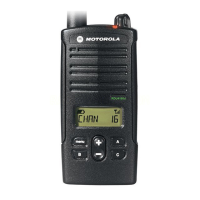7-4 MTR3000 Power Supply: Functional Theory Of Operation
7.3 Functional Theory Of Operation
The following theory of operation describes the operation of the power supply circuitry at a functional
level. The information is presented to give the service technician a basic understanding of the
functions performed by the module in order to facilitate maintenance and troubleshooting to the
module level. Refer to Figure 7-2 for the block diagram of the power supply.
7.3.1 Supply Circuitry
7.3.1.1 Output Over-Current Protection
An over-current condition on either the 28.6 VDC, 14.2 VDC or 5.1 VDC outputs will shut down the
total supply and try to restart. If the over-current continues to exist, the power supply will ‘hiccup’ until
the overload condition is removed, and will not be damaged by the overload. The power supply
recovers automatically after the removal of the overload condition.
7.3.1.2 Over-Voltage Detection and Shutdown
All DC output for either AC or DC inputs are protected from continuous over-voltages by detection
circuits which shutdown the supply and then try to restart itself. If the over-voltage condition
continues to occur, the power supply intermittently shut down and will try to restart. If the over-
voltage condition is removed, the supply automatically recovers. In addition, the 14.2 VDC and the
5.1 VDC outputs are protected by crowbar circuits to limit peak overvoltage.
7.3.1.3 AC Fail Detect
An AC Fail detect signal is provided to indicate (when used with battery backup option) that the
power supply is operating from an external DC source rather than the ac mains. This signal is a TTL
compatible output capable of sinking 1 mA with 10 kΩ pull-up to 5.1 VDC, and is routed to the Station
Control Module. The active-low state indicates ac operation. For the nominal 120 VAC operation, the
signal is active-high (indicating an AC mains failure) when the AC voltage is less than 85 Vrms, but
more than the minimum voltage that guarantees that all outputs will be in regulation at full load.
7.3.1.4 Fan Control
The supply incorporates temperature sense/fan enable circuitry for controlling a 12 VDC fan
mounted on the surface of the heatsink assembly. The power supply circuitry senses the internal
temperature of the power supply. When the internal temperature exceeds a set limit, +12 V is
enabled at J1–1 to turn on the fan. The +12 V fan supply is derived from the +14.2 V output. Power
to the fan is off when the temperature is below the set limit. The fan turns for approximately 5
seconds when power is first applied as a diagnostic indicator that the fan is functional.
7.3.1.5 Over-temperature Protection
The power supply will turn off all outputs when the external temperature exceeds approximately
75°C with the PA operating at full power. The power supply will restart when the internal operating
temperature is reduced below the set point.
Note
To disable the AC Fail Detect alarm in cases where the base station/repeater is running on
DC only input, refer to the Online Help section in the CPS tool.
Note
For procedure to replace the PS fan, refer to Section 14.7.2.1 on page 14-6.

